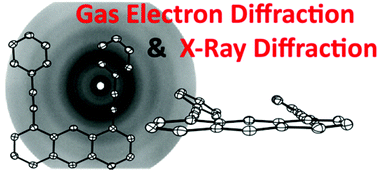1,8-Bis(phenylethynyl)anthracene – gas and solid phase structures†
Abstract
1,8-Bis(phenylethynyl)anthracene (1,8-BPEA) was synthesized by a twofold Kumada cross-coupling reaction. The molecular structure of 1,8-BPEA was determined using a combination of gas-phase electron diffraction (GED), mass spectrometry (MS), quantum chemical calculations (QC) and single-crystal X-ray diffraction (XRD). Five rotamers of the molecule with different orientations of phenylethynyl groups were investigated by DFT calculations. According to these, molecules of C2 symmetry with co-directional rotation of the phenylethynyl groups are predicted to exist in the gas phase at 498 K. This was confirmed by a GED/MS experiment at this temperature. The bonding of this conformer was studied and described in terms of an NBO-analysis. Dispersion interactions in the solid state structure and in the free molecule are discussed. In the solid this symmetry is broken; the asymmetric unit of the single crystal contains 3.5 molecules and a herringbone packing motif of π-stacked dimers and trimers. The π-stacking in the dimers is between the anthracene units, and the trimers are linked by π-stacking between phenyl and anthracene units. The interaction between these stacks can be described in terms of σ(C–H)⋯π interactions.


 Please wait while we load your content...
Please wait while we load your content...